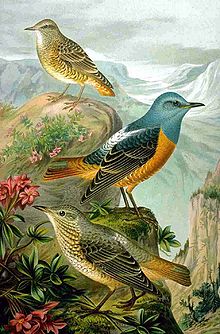- Common Rock Thrush
-
Common Rock Thrush 
Male (center), female (below) and young bird (top). Public domain image from 1905 handbook. Conservation status Scientific classification Kingdom: Animalia Phylum: Chordata Class: Aves Order: Passeriformes Family: Muscicapidae Genus: Monticola Species: M. saxatilis Binomial name Monticola saxatilis
(Linnaeus, 1766)The Common Rock Thrush (Monticola saxatilis),[2] formerly Rufous-tailed Rock Thrush or Rock Thrush, is a chat belonging to the Muscicapidae family. It was formerly placed in the Turdidae family.
It breeds in southern Europe across central Asia to northern China. This species is strongly migratory, all populations wintering in Africa south of the Sahara. It is an uncommon visitor to northern Europe. Its range has contracted somewhat at the periphery in recent decades due to habitat destruction. For example, in the early 20th century it bred in the Jura Krakowsko-Częstochowska (Poland) where none occur today,[3] but it is not considered globally endangered.[1]
This is a medium-sized but stocky thrush 17–20 cm in length. The summer male is unmistakable, with a blue-grey head, orange underparts and outer tail feathers, dark brown wings and white back. Females and immatures are much less striking, with dark brown scaly upperparts, and paler brown scaly underparts. The outer tail feathers are reddish, like the male.[4]
This species breeds in open dry hilly areas, usually above 1500 m. It nests in rock cavities, laying 4–5 eggs. It is omnivorous, eating a wide range of insects, berries and small reptiles. The male Common Rock Thrush has a clear and tuneful song.[4]
Contents
Media
- Videos – Handbook of the Birds of the World
- Video – BirdGuides
- Video – Macaulay Library at Cornell Lab or Ornithology
- Audio and photos - Mangoverde; direct link here
Foreign equivalents
The Common Rock Thrush is called:
- báibēi jīdōng (白背矶鸫 simplified, 白背磯鶇 traditional) in Mandarin.
- koshi jiro iso hiyo dori (コシジロイソヒヨドリ or 腰白磯鵯) in Japanese.
References
- ^ a b BirdLife International (2004). Monticola saxatilis. 2006. IUCN Red List of Threatened Species. IUCN 2006. www.iucnredlist.org. Retrieved on 12 May 2006. .
- ^ English Name Updates - IOC Version 2.9 (July 10, 2011), IOC World Bird List
- ^ Tomek, Teresa & Bocheński, Zygmunt (2005): Weichselian and Holocene bird remains from Komarowa Cave, Central Poland. Acta zoologica cracoviensia 48A(1-2): 43-65. PDF fulltext
- ^ a b Clement, Peter & Hathaway, Ren (2000): Thrushes. Christopher Helm, London. ISBN 0-7136-3940-7
External links
- Oiseaux Photos, map, text.(French)
- Ageing and sexing (PDF) by Javier Blasco-Zumeta

This article about a thrush is a stub. You can help Wikipedia by expanding it.

